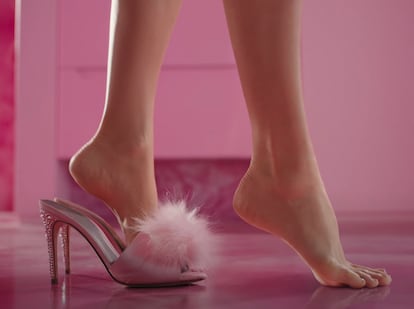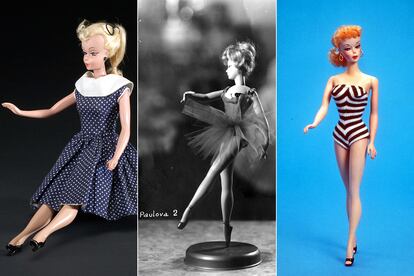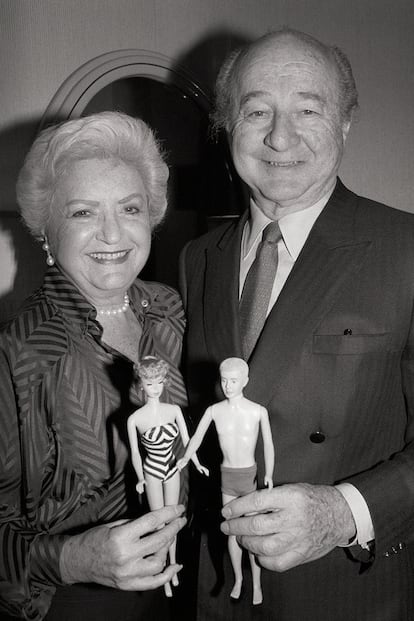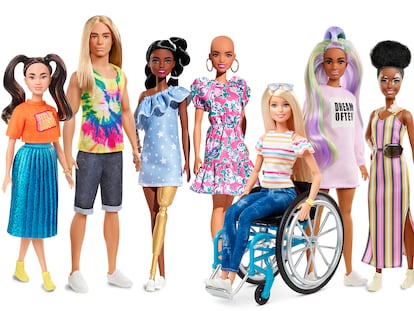Why does Barbie walk on her tip toes?
The doll’s feet have gone viral thanks to Margot Robbie’s new movie, raising questions about the origins of the atypical shape

Directed by Greta Gerwig and starring Margot Robbie and Ryan Gosling, Barbie promises to be one of the highlights of the year for movie theaters. To be released on July 21, the film’s trailer has already made an impact by recreating the beginning of Stanley Kubrick’s 2001: A Space Odyssey with the monolith replaced by the first Barbie model.
“Since the beginning of time, since the first little girl existed, there have been dolls; but dolls were always and forever baby dolls. Until...” says Helen Mirren in the role of narrator as Margot Robbie appears out of nowhere in the black and white striped swimsuit, sunglasses and black heeled sandals of the primordial Barbie doll from March 9, 1959.
The second trailer of the movie has also gone viral and the doll’s feet have once again taken center stage: one of the scenes is a close-up of Barbie taking off her pink mules with a pompom and rhinestone heel, before continuing to walk on tiptoe. ”I need to know everything about this shot,” tweeted model Chrissy Teigen. “How many takes, if she held on to something, was she harnessed, is the landing mark sticky, are they her feet, who did the pedicure, really just a documentary on this shot.”
It wasn’t just Teigen whose curiosity was aroused. Many other social media users also waded in with questions of their own. But how did the Barbie doll come to walk on tiptoe in the first place? What is the origin of the atypical shape of her feet?
Toy historian Juan Hermida explains that Barbie’s predecessor, the German doll Bild Lilli, sold by Hausser in 1955, was responsible. According to Hermida, the doll’s slanted feet shape came about because aesthetically, “it followed the general fashion of the time.” In the 1950s, designers such as Salvatore Ferragamo, André Perugia and Roger Vivier popularized the use of stilettos, which Marilyn Monroe stamped on our collective imagination. And as the Encyclopedia Britannica states, “Barbie officially debuted on March 9, 1959, at the American International Toy Fair in New York City as a creation of Mattel, Inc.’s Ruth Handler. Handler got her inspiration from the German Bild Lilli doll in 1956, and development of the Barbie doll began soon after.”
Lilli — who resembled the movie icon, Marlene Dietrich — had emerged a few years earlier, in 1952, from adult — and, at times, racy — comic strips drawn by Reinhard Beuthien and published in the German tabloid Bild-Zeitung. The cartoons portrayed Lilli as a modern, risqué woman who always wore heels, whether fully dressed or in her underwear.

Bild Lilli was not intended for children. Robin Gerber, author of Barbie and Ruth, the Story of the World’s Most Famous Doll and the Woman Who Created Her, was quoted in an article published in Time in 2015 saying that, “Lilli dolls could be bought in tobacco shops, bars and adult-themed toy stores. Men got Lilli dolls as gag gifts at bachelor parties, put them on their car dashboard, dangled them from the rearview mirror, or gave them to girlfriends as a suggestive keepsake.”
The legend surrounding Barbie’s origins tells how Handler, the daughter of Polish Jewish immigrants who had long wanted to make a doll with an adult aspect, found inspiration on a trip to Switzerland, where she acquired several of these Lilli dolls: one for her daughter Barbara — who gave Barbie her name — and the others to be analyzed by the company. In fact, Barbara was the one who opened her mother’s eyes to a future market as she often played with cut-out dolls in adult shapes, very different from the baby dolls sold at the time, as Greta Gerwig points out in the first trailer of the film.
Handler was determined to produce this new doll, despite the high costs involved and the fact that it went against the grain in the toy industry, as Gerber recalls in his book: “Manufacturers of fashion dolls were not sensitive to the subtleties required to give the doll the kind of imaginative value that Ruth had envisioned,” he wrote. “Their dolls had baby faces, cramped necks, rounded stomachs, flat chests and straight legs, and looked comical in bridal or prom dresses. Ruth believed that teenage girls could not engage in teenage play with these babyish dolls.”
Ruth and her husband, Elliot, pioneered a phenomenon that changed the toy industry. But it wasn’t just Lilli-inspired dolls that were manufactured in the United States. In Spain, Famosa toy company began producing Paulova dolls, named after the Russian ballerina Anna Pavlova, which also had pointed toes, often encased in ballet slippers to match their ballerina dresses. “They went to Germany, to Nuremberg, and discovered Lilli, and the Germans liked the toy tradition that existed in Spain, and that was the reason they let them make these Paulova dolls,” says Juan Hermida. According to this toy historian, the most reasonable thing to do in terms of design, whether for Lilli, Barbie or Paulova, would have been to design feet with a different shape: “The easiest thing stylistically for doll manufacturers was for the foot to be flat, not slanted, because that made it much easier for a shoe to adapt to it. It was something specific to that doll, Lilli, and those that came after her.”

Unlike Barbie, who had tip-toe-shaped feet from the get-go and came with removable shoes, Lilli dolls had the shoe painted on, as M. G. Lord points out in his book Forever Barbie: The Unauthorized Biography of a Real Doll: “The end of her leg is cast in the shape of a stiletto-heeled pump and painted a glossy black,” he wrote. But Handler was very clear that her Barbie doll had to have a good closet, and she looked for details such as painted fingernails and toenails.
Of course, Barbie was criticized years later for producing a stereotype: in 1994 the Jewish feminist magazine Lilith published an interview with Handler in which she was asked about “the objections of many feminists that Barbie presents too idealized and unrealistic an image of women’s bodies — long, long legs, a shortened torso, feet forever pointed for high heeled shoes.” But Ruth argued that her creation had helped many girls: “When we first brought out Barbie, I was very much against her being too pretty or having a distinctive personality,” she said. “I understood the need of little girls to project themselves into their dreams. About feminist criticism: I don’t even respond to that. The fact that Barbie is so loved speaks for itself.” Indeed, Barbie’s feet kept their tiptoe shape until 2015 when the manufacturers introduced a new model with an adjustable ankle to make the foot flat.

Sign up for our weekly newsletter to get more English-language news coverage from EL PAÍS USA Edition
Tu suscripción se está usando en otro dispositivo
¿Quieres añadir otro usuario a tu suscripción?
Si continúas leyendo en este dispositivo, no se podrá leer en el otro.
FlechaTu suscripción se está usando en otro dispositivo y solo puedes acceder a EL PAÍS desde un dispositivo a la vez.
Si quieres compartir tu cuenta, cambia tu suscripción a la modalidad Premium, así podrás añadir otro usuario. Cada uno accederá con su propia cuenta de email, lo que os permitirá personalizar vuestra experiencia en EL PAÍS.
¿Tienes una suscripción de empresa? Accede aquí para contratar más cuentas.
En el caso de no saber quién está usando tu cuenta, te recomendamos cambiar tu contraseña aquí.
Si decides continuar compartiendo tu cuenta, este mensaje se mostrará en tu dispositivo y en el de la otra persona que está usando tu cuenta de forma indefinida, afectando a tu experiencia de lectura. Puedes consultar aquí los términos y condiciones de la suscripción digital.
More information
Archived In
Últimas noticias
Most viewed
- David King, chemist: ‘There are scientists studying how to cool the planet; nobody should stop these experiments from happening’
- Reinhard Genzel, Nobel laureate in physics: ‘One-minute videos will never give you the truth’
- Mexico completes its trade shift with the entry into force of tariffs on China and countries without trade agreements
- Oona Chaplin: ‘I told James Cameron that I was living in a treehouse and starting a permaculture project with a friend’
- Sinaloa Cartel war is taking its toll on Los Chapitos










































